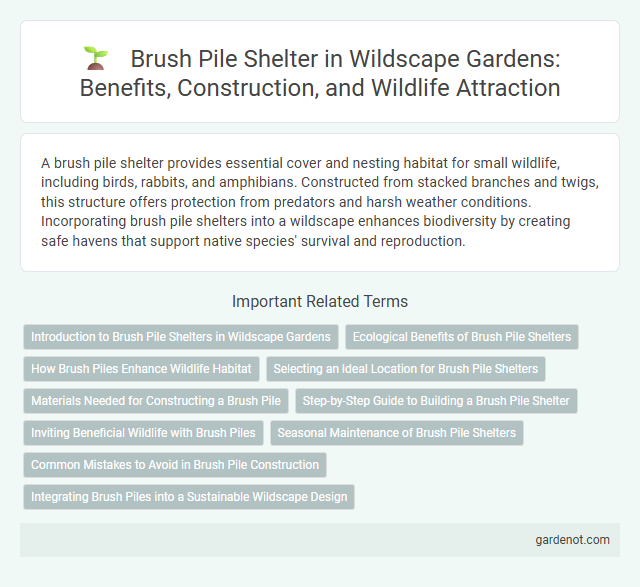A brush pile shelter provides essential cover and nesting habitat for small wildlife, including birds, rabbits, and amphibians. Constructed from stacked branches and twigs, this structure offers protection from predators and harsh weather conditions. Incorporating brush pile shelters into a wildscape enhances biodiversity by creating safe havens that support native species' survival and reproduction.
Introduction to Brush Pile Shelters in Wildscape Gardens
Brush pile shelters in Wildscape gardens provide essential habitats for a variety of wildlife, including small mammals, birds, and insects. These natural structures are created by strategically stacking branches, twigs, and leaves, mimicking the animals' natural environment and offering protection from predators and harsh weather conditions. Brush piles contribute to biodiversity by supporting ecosystem functions such as pest control and nutrient cycling within the garden habitat.
Ecological Benefits of Brush Pile Shelters
Brush pile shelters provide critical habitat for numerous wildlife species, including birds, small mammals, and beneficial insects, enhancing biodiversity in wildscapes. These structures improve soil health by promoting decomposition and nutrient cycling through organic matter accumulation. By offering protection from predators and harsh weather, brush piles support species survival and contribute to ecosystem stability.
How Brush Piles Enhance Wildlife Habitat
Brush piles create essential microhabitats that provide shelter, nesting sites, and protection from predators for various wildlife species such as birds, small mammals, and reptiles. These structures increase biodiversity by offering food sources like insects and seeds trapped within the piled branches. Strategically placed brush piles support ecosystem health by improving habitat complexity and promoting species survival.
Selecting an Ideal Location for Brush Pile Shelters
Selecting an ideal location for a brush pile shelter in a wildscape involves choosing areas that provide natural cover and proximity to food sources like native shrubs or seed-producing plants. Positioning the shelter near water sources enhances wildlife access and supports diverse species seeking refuge. Avoiding open, heavily trafficked zones reduces human disturbance and increases the shelter's effectiveness as a habitat for small mammals, birds, and beneficial insects.
Materials Needed for Constructing a Brush Pile
Constructing a brush pile shelter in Wildscape requires a selection of natural materials including sturdy branches, twigs, leaves, and brushwood collected from the surrounding environment. Durable hardwood branches provide the main framework, while smaller twigs and leafy debris fill gaps to create insulation and protection from the elements. Gathering materials that are dry and not brittle ensures structural integrity and longevity of the brush pile shelter.
Step-by-Step Guide to Building a Brush Pile Shelter
Start by collecting a sturdy frame of branches, arranging larger limbs in a lean-to shape against a support tree or pole. Layer smaller branches, leaves, and brush over the frame to create thick insulation that traps warmth and provides protection from wind and rain. Ensure the shelter's entrance faces away from prevailing winds and add extra foliage near the base to seal gaps and enhance stability.
Inviting Beneficial Wildlife with Brush Piles
Brush pile shelters create essential habitats by providing cover and nesting sites for birds, small mammals, and beneficial insects. These natural structures support biodiversity by attracting species that contribute to pest control and pollination. Strategically placed brush piles in wildscapes enhance ecological balance and promote wildlife activity.
Seasonal Maintenance of Brush Pile Shelters
Seasonal maintenance of brush pile shelters involves removing debris and ensuring structural integrity to provide optimal habitat for wildlife during changing weather conditions. Regular inspection and replenishment of branches enhance shelter effectiveness for small mammals and birds, promoting biodiversity throughout the year. Proper upkeep supports natural behaviors and improves survival rates in brush pile habitats.
Common Mistakes to Avoid in Brush Pile Construction
Avoid stacking wet or green brush in a brush pile shelter, as it leads to mold growth and structural decay, reducing habitat usefulness for wildlife. Ensure the pile is dense but has sufficient gaps to allow small animals like birds, amphibians, and insects to easily enter and find refuge. Position the brush pile away from areas prone to flooding or heavy winds to maintain stability and longevity, preventing collapse that endangers shelter occupants.
Integrating Brush Piles into a Sustainable Wildscape Design
Incorporating brush pile shelters into a sustainable wildscape design enhances biodiversity by providing critical habitats for small mammals, birds, and beneficial insects. Strategically placed brush piles mimic natural debris, supporting ecosystem functions such as pest control and soil enrichment. Utilizing locally sourced materials for brush piles promotes resource efficiency and aligns with ecological restoration principles in wildscape planning.
Brush pile shelter Infographic

 gardenot.com
gardenot.com